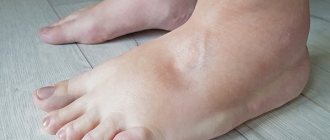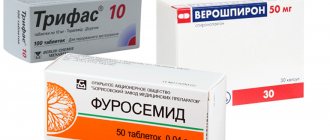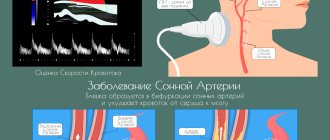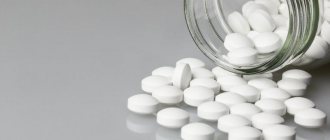Edema is a condition in which excessive amounts of fluid accumulate in certain organs or intercellular spaces. Swelling of the legs is especially common, since the lower extremities are constantly exposed to increased stress. The fluid is mainly localized in the area of the legs and feet.
Swelling can occur on one limb or on both. They usually appear in the evening.
Physiological reasons
In a healthy person, edema may appear in the evenings after heavy physical exertion or prolonged standing as a result of increased hydrostatic pressure in the blood vessels. The likelihood of swelling increases in the heat, when staying in a stuffy room or at high altitude, when drinking a large volume of liquid, excessively enjoying salty foods, and abusing alcoholic beverages (salt and alcohol retain water).
Swelling of the feet is especially common in women when wearing high-heeled or high-platform shoes. Due to the unnatural position of the foot, blood circulation in the lower extremities is significantly impaired, which leads to stagnation and accumulation of fluid. Similar processes are observed if you wear too narrow shoes and shoes with flat soles.
For physiological reasons, the swelling is mild and symmetrically covers the ankles and feet (occasionally the lower legs). When pressed with a finger, they leave an instantly disappearing mark. After rest they disappear completely.
If the legs swell for physiological reasons in women and men, then there is no need for special treatment. It is enough to adjust your lifestyle.
Hormonal fluctuations in women
In women, before the onset of menstruation, the concentration of progesterone in the blood decreases, which can cause fluid retention, causing pasty (swelling) ankles. Swelling is most pronounced during premenstrual syndrome.
During menopause, hormonal levels are constantly changing, so women may periodically swell their lower extremities. This problem can also be the result of hormone replacement therapy.
During reproductive age, swelling of the legs may occur when taking oral contraceptives.
Pathological causes
Quite often the legs swell in people with health problems.
Swelling is a symptom that accompanies:
- Traumatic injuries When injured, the skin usually becomes bluish or purple, abrasions and bruises appear, and the tissues become swollen. In case of injury, the swelling is always one-sided, located at the site of injury, and can spread to nearby tissues. Swelling of the limb is possible with bone fractures, dislocations, ligament damage, meniscus tears, severe bruises, burns, frostbite.
- Purulent processes With purulent lesions of the skin, soft tissues, bones, joints, dense swelling is localized in one place, quickly increasing in size. It is combined with redness or cyanosis of the skin, jerking pain, and signs of intoxication of the body.
- Kidney diseases Due to malfunctions of the kidneys, their filtering abilities are impaired and the tubules are damaged. As a result, the kidneys do not have time to remove fluid from the body, which is why it moves from the blood vessels into the tissues, which causes swelling of the feet and legs. In this case, the swelling is symmetrical, soft, watery, and elastic. In addition to the legs, they cover the arms, stomach, and face. They appear very quickly, often in the morning. An additional symptom is yellowing of the skin. Most often, the lower extremities swell with nephritis, pyelonephritis, glomerulonephritis, renal amyloidosis, nephrosis, membranous nephropathy, chronic renal failure.
- Pathologies of the heart and blood vessels In diseases of the cardiovascular system, edema is symmetrical and dense, pasty ankles and feet may be observed. Occasionally, swelling completely covers the lower leg, reaching the knees. In this case, swelling appears and resolves very slowly (within several weeks), the skin acquires a bluish tint and becomes cool. Most often, swelling of the legs is evidence of the initial stage of varicose veins. In this case, the swelling is accompanied by pain and heaviness in the lower extremities. Later, other signs appear - convulsions, protruding veins. In healthy people, due to the contraction of the muscles in the legs, venous blood moves from bottom to top. Venous valves prevent blood from flowing in the opposite direction. With varicose veins and thrombophlebitis, the functioning of the valves is disrupted, which is why blood begins to move in two directions. At the same time, it stagnates in the veins, which leads to increased venous pressure, thinning of the vein walls, and loss of tone. As a result, the permeability of the vessels increases, the fluid from them moves into the surrounding tissues, causing swelling. In addition, due to stagnation, the blood thickens, which increases the risk of blood clots. Swelling can be a symptom of thrombosis, cardiomyopathy, cardiosclerosis, cardiac amyloidosis, arterial hypertension, postthrombophlebitis disease, arrhythmia, constrictive pericarditis, heart failure. Due to impaired lymph outflow, edema can occur due to lymphostasis, lymphedema, removal of lymph nodes, or compression of lymph vessels by tumors. In this case, the swelling is one-sided, very dense and persistent. When pressing with a finger, a dent does not form.
- Joint diseases A common cause of swelling of the ankle and knee joints is arthritis (rheumatoid, psoriatic, gouty, reactive, infectious) and arthrosis. In arthritis, swelling can be symmetrical and asymmetrical, unilateral and bilateral. It is combined with pain, hyperthermia, local hyperemia, a feeling of stiffness, and limitation of movements. With arthrosis, swelling is almost invisible, intensifying during periods of exacerbation.
- Metabolic disorders A common cause of swelling is metabolic disorders (for example, diabetes mellitus). The problem is aggravated in obese people, whose lower limbs are subject to increased stress.
We treat all types of edema
Specialists at the Yauza Clinical Hospital diagnose and treat edema of various origins. We follow international protocols and use modern equipment.
For cardiovascular diseases
“Cardiac” edema develops slowly – over several weeks or months. They are characterized by symmetry and increase in size in the evening. They first appear on the lower extremities or lower abdomen, in severe cases they spread throughout the body and are accompanied by the accumulation of fluid in the abdominal cavity (ascites) and enlarged liver. In this case, the skin most often feels cold to the touch and the swelling is dense. When pressed, a hole remains.
Patients complain of shortness of breath, which worsens when lying down, and low exercise tolerance. They have wheezing in the lungs, tachycardia, pallor of the lips, and cyanosis of the nasolabial triangle. As circulatory failure is compensated, swelling decreases or disappears.
Swelling due to venous insufficiency also becomes more pronounced in the evening, causing the sensation of shoes suddenly becoming tight (due to swelling of the feet), and the legs become visually thicker, often not symmetrically. Swelling in the legs is accompanied by a feeling of heaviness, fatigue, and pain in the legs. Spider veins and an enhanced pattern of veins are noticeable on the skin. In severe cases, swelling persists constantly, cramps in the calves are possible, trophic changes develop - thinning of the skin, persistent redness, peeling, itching, and poorly healing ulcers. Timely professional medical care helps prevent or reduce the risk of such progression of the disease.
For kidney diseases
“Renal” edema can develop very quickly - in less than a day. Swelling appears mainly on the face. Swelling under the eyes is noticeable in the morning. They can also be localized on the limbs and abdominal wall. When changing postures, bodies quickly shift. Fluid accumulation often occurs - ascites or hydrothorax. Edema skin is soft or dense, pale, dry.
Swelling due to kidney disease may be accompanied by a decrease in the amount of urine excreted, a change in its color, and possibly the appearance of blood (red blood cells) and protein in a urine test. Pain appears in the lumbar region. Nonspecific manifestations include headache and weakness. Shortness of breath and liver enlargement, characteristic of circulatory failure, are not observed. Renal edema can be a consequence of an infectious disease (tonsillitis, viral infection, etc.) and requires observation and treatment by a specialist (nephrologist, rheumatologist, therapist).
Allergic
Allergic edema develops quickly (in a few minutes) and is regional in nature. They arise as a result of contact with an allergen or an insect bite. They develop most often on the face (eyes, eyelids, mucous membranes, lips), arms (fingers, hands), elbows and knees.
The development of allergic edema is accompanied by itching and rash. In severe cases, due to bronchospasm, attacks of difficulty breathing are possible, usually in the exhalation phase. Swelling of the larynx can lead to suffocation and pose a threat to the patient's life. Therefore, patients prone to such a reaction should be prepared for a dangerous situation.
It is necessary to discuss in advance with the doctor what medications will help the patient safely wait for the ambulance to arrive (delivery to the hospital) in case of an acute allergy attack and always have them available.
Prolonged swelling causes stretching of the skin, makes blood vessels less elastic, and impairs blood circulation. Swelling negatively affects the joints and causes difficulty moving. Ulcers may develop at the site of swelling, which are subsequently difficult to treat. Don't take things to the extreme. Make an appointment with a doctor and get rid of the problem.
Other reasons
The answer to the question “Why do my legs swell and how to deal with it?” People suffering from:
- endocrine pathologies (myxedema, hypothyroidism, hyperaldosteronism, Ishchenko-Cushing's disease);
- exhaustion (anorexia nervosa, nutritional cachexia, severe weight loss after serious illness or surgery);
- nervous disorders (paresis, paralysis).
In the above cases, the edema is mild or moderate, symmetrical (with the exception of unilateral paralysis), soft. They do not change during the day, occasionally increasing in the evenings.
- Allergic reactions Under the influence of allergens, fluid rapidly accumulates in the tissues, which leads to instant swelling of the legs. In this case, the skin becomes red in color and itching appears.
- Obesity Due to excess weight, pressure on the lymphatic vessels and veins increases, which leads to disruption of lymphatic and venous outflow.
- Taking medications Some medications (vasodilators, antihypertensives, antidiabetics, calcium channel blockers, nonsteroidal anti-inflammatory drugs) can cause swelling of the lower extremities.
Methods for relieving leg swelling
To alleviate the patient’s condition, the phlebologist prescribes wearing knitwear, massages, certain gymnastic exercises, water treatments, ointments and medications. As a rule, a whole range of treatments is used for varicose veins. Let's explain each method in more detail.
Compression jersey (anti-varicose). Its task is to normalize the functioning of the circulatory system in a certain area due to the precise distribution of pressure on the leg or pelvis. It is used in the initial and advanced stages of varicose veins.
There are several types of compression hosiery: tights, stockings, knee socks, socks. It is also used as a method of preventing varicose veins. If you will be standing or sitting all day, wear compression stockings. It will prevent blood from pooling in the vessels and improve blood circulation.
Physiotherapy. A large number of light exercises have been developed that are suitable for specific causes of the disease and training conditions. For example, for home exercises, try exercises called scissors. While sitting at a workplace in the office, circular rotation of the feet is suitable. During a long flight or trip, it is better to use ointments prescribed by your doctor.
Massotherapy. Self-massage is painful. Especially if you combine the procedure with the use of external treatments, such as compression stockings or creams. An experienced massage therapist will make the procedure painless. Typically, massage is prescribed after surgery to remove varicose veins.
Water procedures. A contrast shower or a visit to the pool is prescribed as a water massage. A contrast shower is an alternating change in water temperature from warm to cool. This method improves blood circulation, prevents capillary fragility and strengthens the walls of blood vessels. Provides relief and prevention of new swelling.
Medicines. Prescribed individually and directly by your attending physician. The phlebologist selects medications to gently and effectively relieve swelling of the legs.
Swelling of the legs during pregnancy
Why do pregnant women's legs swell? Physiological and pathological reasons can cause the problem. Physiological factors include increased stress on the legs as a result of weight gain, hormonal changes (increased progesterone concentration), and compression of the inferior vena cava by the uterus. The pathological cause is gestosis (late toxicosis). In this case, the severity of symptoms can vary greatly - from slightly noticeable pastiness to severe swelling of the entire body (lower and upper limbs, face).
Why does leg swelling increase in hot weather?
In hot weather, the body tries to restore heat metabolism by dilating blood vessels. As a result, blood flow to the lower extremities increases, and, if there is pathology of the venous or lymphatic system, the appearance of edema increases.
Types of leg swelling
Depending on the cause, there are several types of edema:
- stagnant - develop due to stagnation of venous blood and increased vascular permeability in people with varicose veins and thrombophlebitis;
- hydromic – accompany kidney disease;
- neuropathic – typical for people suffering from diabetes and alcoholism;
- cachectic - occur with nutritional deficiency caused by chronic anemia, lack of protein in food, the presence of malignant tumors;
- allergic – the body’s reaction to exposure to allergens;
- mechanical - the result of compression of blood vessels, injury to bone or soft tissue structures/
Diuretic herbs
Herbs with a diuretic effect are prescribed by a doctor for extensive swelling of the face, arms and legs if there is kidney failure or severe inflammation of the urinary system. If conservative treatment methods have not brought visible results, then properly selected herbs can bring relief and solve the patient’s problem.
Many medicinal plants have a diuretic effect. The most popular, affordable and effective: chamomile, bearberry, rose hips, nettle, milk thistle. Diuretic herbal mixtures for edema can not only reduce the amount of fluid in the body, but also improve heart function. Hawthorn copes well with this serious task. Despite the fact that it has a weak diuretic effect, improving the functioning of the heart muscle allows you to eliminate edema and other unpleasant symptoms. Hawthorn goes well with bearberry, which enhances the diuretic effect.
Back to articles
Diagnostics and tests
At the initial appointment, the therapist listens to the patient’s complaints, conducts a physical examination and palpation, and collects an anamnesis of the disease.
A diagnostic examination for swelling of the legs will help to find out the causes and select treatment for women and men:
- general and biochemical blood test - detects gout and atherosclerotic damage to blood vessels;
- blood sugar test - determines diabetes mellitus;
- blood test for hormones – examines hormonal levels;
- general urinalysis – assesses kidney function;
- Ultrasound – detects diseases of blood vessels, heart, kidneys, endocrine glands;
- electrocardiography – diagnoses cardiac pathologies;
- X-ray – detects fractures and joint diseases.
If necessary, Doppler ultrasound, duplex scanning of blood vessels, electroencephalography, CT, and MRI are additionally performed.
Based on the diagnostic results, the therapist can give a referral to specialized specialists (phlebologist, angiosurgeon, cardiologist, nephrologist, hepatologist, urologist, gastroenterologist, endocrinologist, orthopedist).
Treatment
There are many ways to quickly solve the problem, but the result is temporary. To get a stable effect, it is necessary to establish why the legs swell and eliminate the cause of the pathology.
Conservative therapy
If your legs swell very much, your doctor will tell you what to do. He will select medications depending on the cause of the problem.
For pathologies of the kidneys and heart, diuretics and antihypertensive drugs, immunosuppressants are prescribed, and hemodialysis is performed according to indications.
For varicose veins, the doctor selects phleboprotectors or venotonics. These drugs strengthen the veins and normalize venous circulation. Special ointments and compression garments will help relieve unpleasant symptoms.
For heart diseases, diuretics, vasodilators, adrenoblockers, ACE inhibitors, glycosides, and anticoagulants are selected.
For joint diseases, non-steroidal anti-inflammatory drugs (in the form of ointments, tablets, injections), physical therapy, massage, and physiotherapy are recommended. In case of fractures and dislocations, a plaster cast is applied or skeletal traction is used. Additionally, analgesics, massage, and physiotherapeutic procedures are prescribed.
Local infections are suppressed with antibacterial, antiviral or antifungal drugs.
Lymphatic drainage massage provides a good effect. It activates metabolism and lymph flow, which eliminates puffiness. Additionally, therapeutic and compression therapy, taping, osteopathy, and manual therapy are recommended. Physiotherapeutic procedures improve local blood circulation, relieve inflammation and pastosity.
Surgery
If conservative treatment does not have the desired effect for swelling of the legs, surgical intervention is recommended:
- For heart pathologies: o pericardiectomy – the pericardium is removed; o interventions on valves, partitions, chambers; o radiofrequency ablation; o implantation of a pacemaker.
- For vascular diseases: o sclerotherapy; o phlebectomy; o thrombectomy; o thrombolysis; o laser coagulation; o EVLO; o RFO; o bypass surgery; o tunneling.
- For kidney damage: o organ transplantation.
- For joint diseases: o arthroplasty; o arthrodesis; o endoprosthetics.
- For traumatic injuries: o plastic surgery of ligaments; o osteosynthesis; o meniscectomy.
- During purulent processes: o opening of abscesses, phlegmons, boils, carbuncles; o arthrotomy; o sequestrectomy.
What to do with swelling
If swelling develops, especially if it is chronic, you should immediately consult a doctor. To establish the true cause of fluid accumulation, specialists will definitely prescribe a wide range of studies. As a rule, diagnosis begins with a physical examination of the patient and collection of anamnesis, after which the patient undergoes tests and, if necessary, undergoes instrumental examinations.
• General and biochemical blood tests show the level of red blood cells, hemoglobin, ESR, cholesterol. This is necessary to exclude atherosclerotic vascular lesions and gout. • Blood sugar test to rule out diabetes. • Urinalysis to quantify protein levels. • Hormonal tests. • Ultrasound and electrocardiography to detect heart and vascular diseases.
After general examinations, the doctor can refer the patient to specialized specialists for additional diagnostics if certain pathologies are suspected. For example, if varicose veins are suspected, an ultrasound scan of the veins in the legs may be prescribed. In any case, diagnosis and therapy should be carried out exclusively by a doctor. It is important to eliminate not only swelling, but the underlying disease that caused it. The type (drug or non-drug, surgical, conservative) and intensity of therapy are also selected by a specialist. For example, for heart or kidney disease, certain diuretics are prescribed.
When it comes to varicose veins, the basic drugs are venotonics or phleboprotectors, which correct disturbances in the functioning of the venous circulatory system, strengthen blood vessels and restore venous flow. Special ointments and gels are also used that reduce skin sensitivity and discomfort in areas of swelling. In some cases, wearing compression garments is indicated to relieve symptoms. In the later stages of varicose veins, the problem can only be solved through surgery - for this, phlebectomy, sclerotherapy or EVLO (endovasal laser obliteration) is prescribed. However, in some cases it is possible to get rid of swelling without medication or surgery.
Osteopathy is a system of diagnosis and treatment of diseases of the musculoskeletal system, internal organs and systems without drugs. It is based on the anatomical-functional unity of the body and uses manual methods that restore the body's ability to heal itself.
Changes in the legs can be caused by weakness, overexertion, muscle or joint stiffness. The osteopathic correction scheme depends on the complexity, severity of the pathological process and the root causes that caused it.
In the initial stages of the disease, osteopathic manipulations help avoid the progression of leg disease, preventing the need for drug therapy and surgical intervention on the legs.
Osteopathic medicine views the human body as a single system that constantly adapts to new conditions. When any organ is ill or injured, other systems regulate and compensate for its functioning, which causes pain, swelling or inflammation.
Osteopathic treatment of swelling at the Quality of Life clinic is aimed at normalizing metabolism and digestive processes, which has a beneficial effect on the health of the entire body as a whole. Osteocorrection affects all systems, normalizes their functioning and brings them to a natural state. It allows you to effectively eliminate all negative phenomena, including swelling, shortness of breath, heartburn, disturbances in the gastrointestinal tract and the musculoskeletal system. Osteopathic medicine has no contraindications and can be used by both pregnant women and children.
Our doctors use gentle techniques that relieve tension, normalize blood circulation and lymph flow in the legs, improve vascular tone, provide lymphatic drainage and reduce fluid accumulation. In addition, this impact:
• relaxes muscles and fascia; • reduces or completely eliminates pain; • normalizes metabolism and hormonal levels; • restores anatomical mobility of joints.
Work is also carried out at the level of the diaphragm - thoraco-abdominal and pelvic. This normalizes pressure in the abdominal cavity, restores the functionality of all organs and systems, including blood vessels, which, due to disorders, are forced to work harder. As a result, the entire body is brought into a state of harmonious balance, which has a positive effect on the hormonal and psycho-emotional background. Working with soft tissues normalizes blood and lymph flow. This improves the nutrition of bones and joints, which do not have blood vessels, so the main source of nutrients in them is only the surrounding tissue. Improving bone nutrition eliminates pathological processes faster.
Treatment with lymphatic drainage massage is highly effective. It improves lymph flow, accelerates metabolic processes, relieves swelling and stabilizes the functioning of the central nervous system. This method is combined with other physiotherapeutic procedures - physical therapy, kinesiological taping, compression therapy.
Complex therapy, combining different methods, promotes a speedy recovery by reducing inflammation and swelling of tissues, improving blood circulation at the site of inflammation. As a result, recovery occurs much faster. Preventive courses every six months reduce the likelihood of exacerbations of swelling in the legs. The combination of osteopathy, manual therapy, kinesiotherapy and exercise therapy forms new motor patterns in the legs, stops the progression of diseases, prevents exacerbations and improves the quality of life. The set of physical exercises is selected individually by the attending physician, but even if you do simple movements correctly, they will have results.
Prevention
To avoid the question: “Your legs are swollen, what should you do?”, you should follow some rules:
- eat rationally - include more foods containing potassium in the menu and minimize the consumption of foods rich in sodium;
- wear comfortable low-heeled shoes;
- do not sit for a long time with your legs tucked or your legs crossed;
- massage your feet periodically;
- take a contrast shower, arrange foot baths;
- lead an active lifestyle: walk, swim, do aerobics;
- when resting and during sleep, place your feet on a pillow or bolster so that they are located above the level of the heart;
- to refuse from bad habits;
- undergo preventive examinations in a timely manner and treat concomitant diseases.











